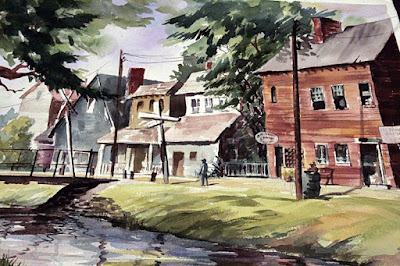11/9 - Will Einser, a Contract with God
Answer either, or more than one:
1. Here is an account of the short-story cycle exhibit in which Will Eisner's A Contract with Work is featured: https://www.nypl.org/blog/2016/05/03/short-story-cycles. What to you are the most significant links between the stories in this book?
2. As your classmates who will be presenting on Tuesday will deal mostly with the first eponymous story, "A Contract with God", we might for now focus on "The Street Singer" and "The Super". What can you say about class representation in both of these stories? And/or sexuality?
3. Here several visual elements are treated aesthetically, just like in the common short story linguistic elements are arranged in surprising ways. What would you say are the most striking visual markers in either "The Street Singer" or "The Super" or both?
4. In what way does the visual representation in this work differ from the common comic strip (for the fans of the genre)?
1. Here is an account of the short-story cycle exhibit in which Will Eisner's A Contract with Work is featured: https://www.nypl.org/blog/2016/05/03/short-story-cycles. What to you are the most significant links between the stories in this book?
2. As your classmates who will be presenting on Tuesday will deal mostly with the first eponymous story, "A Contract with God", we might for now focus on "The Street Singer" and "The Super". What can you say about class representation in both of these stories? And/or sexuality?
3. Here several visual elements are treated aesthetically, just like in the common short story linguistic elements are arranged in surprising ways. What would you say are the most striking visual markers in either "The Street Singer" or "The Super" or both?
4. In what way does the visual representation in this work differ from the common comic strip (for the fans of the genre)?




In response to question 3, I found the addition of visual components to the linguistic elements of the story to be very effective in creating an emotional reading experience. Without pictures, the reader can only feel a limited range of emotions. The inclusion of visual cues adds an entirely new element to the story, and allows a much wider range of emotions to be felt by the reader.
ResponderExcluirThroughout The Street Singer, Eisner uses close-ups on the characters’ faces to highlight both their feelings of sorrow and of elation. Because he can use pictures, he does not have to describe them with words. The saying “A picture is worth a thousand words” is definitely confirmed by Eisner’s work; it would take dozens of words to describe the sunken, sleepy face of the street singer. But, the most powerful use of graphic material in The Street Singer (in my opinion), does not involve the depiction of faces. Rather, it is Eisner’s use of birds-eye views to depict the street singer within the alleys between tall buildings. The first example of this is on page 67, in which the reader is positioned as if he/she is looking down to the alley from an upper story apartment window. The street singer looks up, mouth wide open in song. I interpreted the use of this angle as a means for the author to depict the “ therness” or inferiority of the street singer from those who live in the high rise apartments. The reader is above him, giving them a sense of power and superiority. Because Eisner describes the street singers as “victims of the hard times,” it is likely that this was his intention.
This motif returns on page 78, after the street singer leaves Marta Maria’s fancy upper level apartment. The distancing of him from her begins as he walks down a flight of stairs, as she peers down over the upper level banister. The following frame once again shows him walking within the narrow alleys with his head down, as Marta Maria watches from above. Combined with the literary elements of this story — which involves a rich woman attempting to exploit the talents of the poor man — the visual elements of this story give the reader a multi-dimensional experience of class-conflict, or social-stratification during the Great Depression.
In response to the first question, the stories are linked in several ways. In relation to the article, the stories share a setting as well as common themes.
ResponderExcluirFor instance, the stories are all centered on the tenements of Dropsie Avenue in the Bronx during the Great Depression in the early 1930s. The final story, however, is interesting because it adds another setting as the characters go on vacation. Nonetheless, the characters all ultimately return back to the Bronx, which gives the impression that Dropsie Avenue is the true setting for these characters. In effect, their lives come full-circle again, and their vacation setting is seemingly transient, although their harrowing experiences there endure.
Furthermore, I found it interesting how the stories all more or less share common themes, and at least one seems actually to increase in intensity with each story in a controlled and measured way. The theme of sexuality begins in the first with four brief pages where Hersh’s mistress appears (38-41). Yet there really is no moment of sexual desire depicted, neither in word nor image. In the second story, it increases to where the street singer sleeps with Diva Marta Maria, which is depicted over about three pages (75-77), and there are brief moments of nudity. Yet while it is more explicit and intense, it is still concentrated to a few pages. The street singer, however, is married, and so this story adds the first indefensible element in relation to sexuality.
In the third one, it increases further, in which there are now more pages dedicated to depicting some form of sexual desire as well as nudity, and this time, it also depicts sexual acts with children, adding a new untenable dimension. The fourth one then greatly expands not only in its page count and its intensity, but also in the range of characters that are involved romantically or sexually with others, including in ways that, expanding on the two before, are unjustifiable. Goldie, one of the characters, is raped, Maralyn sleeps with Willie even though he is underage, and Sam has been cheating on his wife with a mistress for three years.
Mike Neary
In response to question 4, the story most obviously differs from the comic strip format with its changing layout and larger space for single scenes.
ResponderExcluirThe un-restricted layout allows the author to both group scenes that may fit well together which leaves the reader with a better idea of the statement the author is trying to make about that one topic. For example in the "SUPER" (123) the collection of images showing the SUPER mourning over his dog leaves the reader with a greater understanding of his emotions than if they had been grouped with other images that didn't relate to the same scene. With this changeable format the author is able to better convey themes and ideas to the reader by grouping images in whatever combination he feels will best make the statement.
Most comic strips try to gather many images together in small spaces and it can often cause the statement of one panel to be lost. With the freedom of a large space, Eisner was able to emphasize and highlight things that add complexity to the story being told in the panel. On page 101 the full page photo of the SUPER makes him look like a scary figure, but because of the large space Eisner is able to add the smaller figure of a man retreating which adds a different feeling to the picture besides the initial judgement we have of the SUPER. Combined with the text on the page and the man's wide-eyed, rather ignorant looking expression the reader is left wondering if maybe the SUPER is not scary, but the the man in the background and others have just misjudged him. Without the larger space the man in the background would have been lost and the reader might have just been left simply judging the SUPER as a bad person.
The differing format from the comic strip allows Eisner to explore differing ways to present the statements he wishes to make in panels.